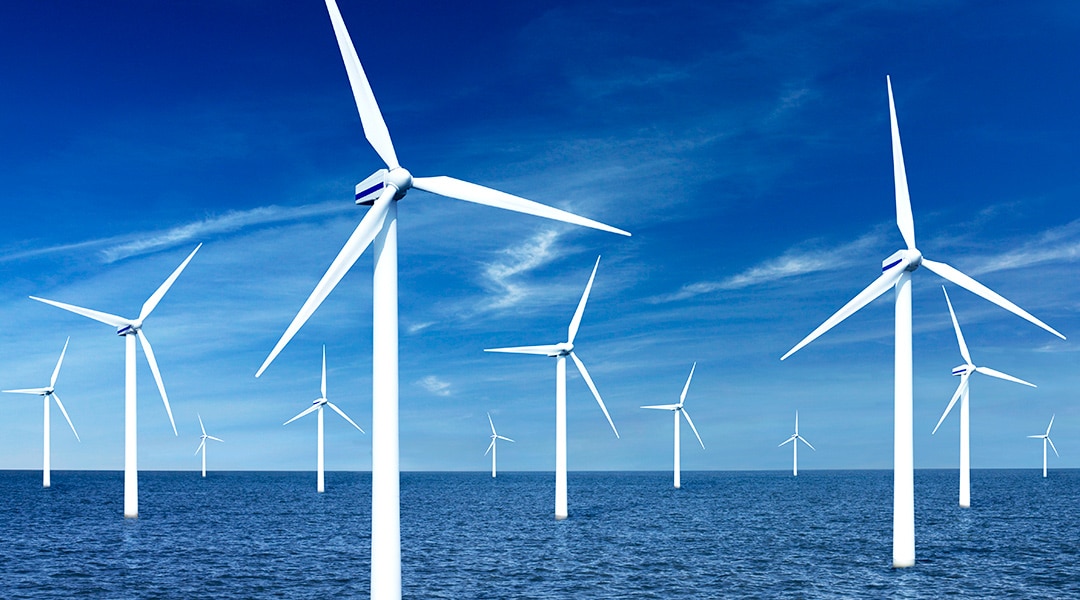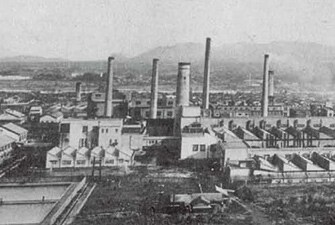#05
The materials that are building a renewable energy economy
To halt the rise of harmful greenhouse gas emissions, we need to convert as many sectors of the economy to renewable energy as quickly as possible. Advanced materials are improving the efficiency of the renewable energy industry while helping other sectors, such as transport, adapt to electrification.

Anchored to the sea bed off the northwest coast of England, massive wind turbines turn silently to harvest the breeze. These gentle giants are some of the biggest in operation today, standing around 640 feet high – more than twice the height of the Statue of Liberty – with blades 270 feet long. They form the largest offshore wind farm in the world, producing enough green energy to power 600,000 homes. But it is a distinction that may not last long. Every year, manufacturers launch bigger and more efficient wind turbines. That they are able to do so is largely thanks to advances in materials science.
The blades of a wind turbine hold the key to its power and efficiency. They need to be strong enough to withstand gale-force winds, yet light enough not to buckle under their own weight, and durable so as to last the 25-year life of a wind turbine.
Carbon fiber is one of the few materials that combines strength with lightness and durability, which is why – despite its higher cost – it is now the material of choice for the strong skeleton of a blade. Zoltek, a subsidiary of the Toray group of companies, supplies more than 12,000 tonnes of carbon-fiber materials to the wind energy market every year. “One of the appealing facets about carbon fiber spar caps is that it opens the door to design not only lighter, but thinner blades with improved aerodynamic performance,” says Philip Schell, executive VP at Zoltek.1
Toray’s carbon fiber is just one way in which materials science is contributing to the sustainable industries of the future. As the world attempts to reduce its dependence on fossil fuels, it is the innovations introduced by the materials industry – including weight-reducing materials, eco-friendly substitutes for plastic, next-generation solar cells and advances in fuel-cell technology – that are helping to usher in a new era of low-carbon growth.
1 Interview in Composites World, 3/27/2018
Lighting the way
Solar power has also experienced rapid development in the past decade, thanks to innovations that have made solar modules both cheaper and more efficient at transforming light into electricity. Toray is now developing practical applications for the next generation of solar cells, which use organic compounds rather than rigid, crystalline silicon to conduct electricity. These carbon-based materials absorb more light than inorganic silicon, meaning that they will work indoors and in low-light conditions. They are also extremely thin – only submicrons (a millionth of a meter) thick – giving organic, thin-film solar cells unparalleled flexibility and efficiency.
Toray envisions these solar cells being sewn on to clothes, coated on windows or the sides of buildings, and used as the power supply for indoor sensors, which will become increasingly important with the Internet of Things (IoT). For now, it has successfully tested a solar cell installed in a wireless sensor, which performed well even with indoor lighting. “A self-contained power source is indispensable in a wireless communications network,” the company explains. “The IoT will require a vast number of sensors to connect everything wirelessly, each with its own power supply. Batteries are troublesome, costly and require replacing, so solar cells that can supply electricity endlessly if there is light are promising candidates as autonomous power sources.”
Driving green innovation
With renewable energy now growing faster than all other forms of electricity production, the race is on to convert as many industries as possible to low-carbon fuels. Electrifying energy consumption – from the way we heat and light buildings to the way we transport goods, people and services – is at the center of global decarbonization, says the World Business Council for Sustainable Development.
The automotive industry is also using carbon fiber in the shift to electric cars. Toray’s flagship electric vehicle, the Teewave AR1, for example, features carbon fiber in its basic structure, including the bonnet, dashboard and roof, while shock absorbers, made from carbon fiber composites, have greater rigidity to offer more protection during crashes. Crucially, the car is also lighter. It weighs a third less than other commercial electric vehicles, reducing CO2 emissions by nine percent.
The carbon fiber of the future
The development of carbon fiber has not been without its challenges – notably, the need to recycle it responsibly. But investment in innovation is starting to pay off. In partnership with Toyota Tsusho, Toray developed the technology to extract and reuse the gas that is emitted when carbon fiber waste is burned.
Converting transport to clean electricity is particularly pressing because, at present, transport is almost completely dependent on petroleum-based fuels. Sales of electric vehicle (EV) are growing exponentially, with four million EVs on the road in mid-2018, although they still represent only a tiny fraction of vehicles sold worldwide. Nevertheless, EVs are expected to win an ever-bigger market share as costs come down and the efficiency and range of batteries are extended. And here, the Toray Group is playing a critical role, with innovations that are improving the performance and reliability of lithium-ion batteries, including the battery’s separator film, insulation film and their manufacturing equipment.
In addition to supporting renewables and EVs, Toray is investing in technologies and R&D to promote a hydrogen-based society.
Hydrogen can be extracted from many sources, including water, and when it is made with renewable energy it is completely carbon-free. When it is recombined with oxygen to produce electricity, the only emission is water. Moreover, unlike wind or solar power, hydrogen can piggyback onto existing infrastructure to store and transport natural gas.
Fuel-cell vehicles, which use hydrogen gas to power an electric motor, are seen as an alternative to battery-powered EVs in some parts of the world. Toray is developing various products for the hydrogen supply chain, from the membranes and materials required in electrolysis equipment and fuel cells, to carbon fiber for hydrogen gas-storage tanks.
Together with other Japanese partners, Toray is investing in the development of “power to gas” systems, which use renewable energy to manufacture and store hydrogen. The Japanese government, and the Tokyo Metropolitan Government in particular, are channeling resources into hydrogen infrastructure, such as refueling stations. The capital hopes to have more than 6,000 fuel-cell cars and a large number of fuel-cell buses on the road in time for the Tokyo Olympic Games in 2020 – dubbed the “Green Games”.
It is clear that the transition to a low-carbon economy will take many paths. Technologies that support and reinforce each other, such as renewables and hydrogen fuel, enable other industries to become more sustainable. By investing in green innovation, Toray has become a key player in the low-carbon economy of the future.



